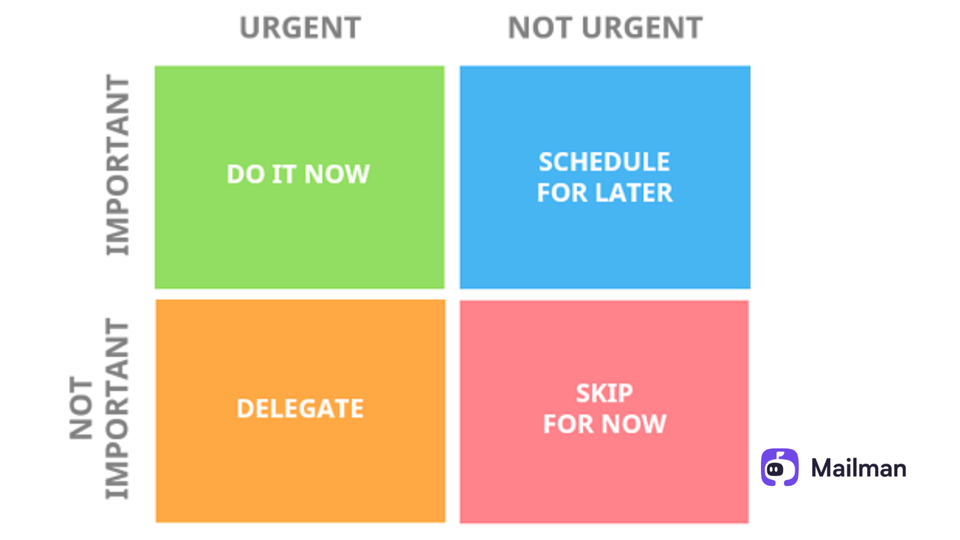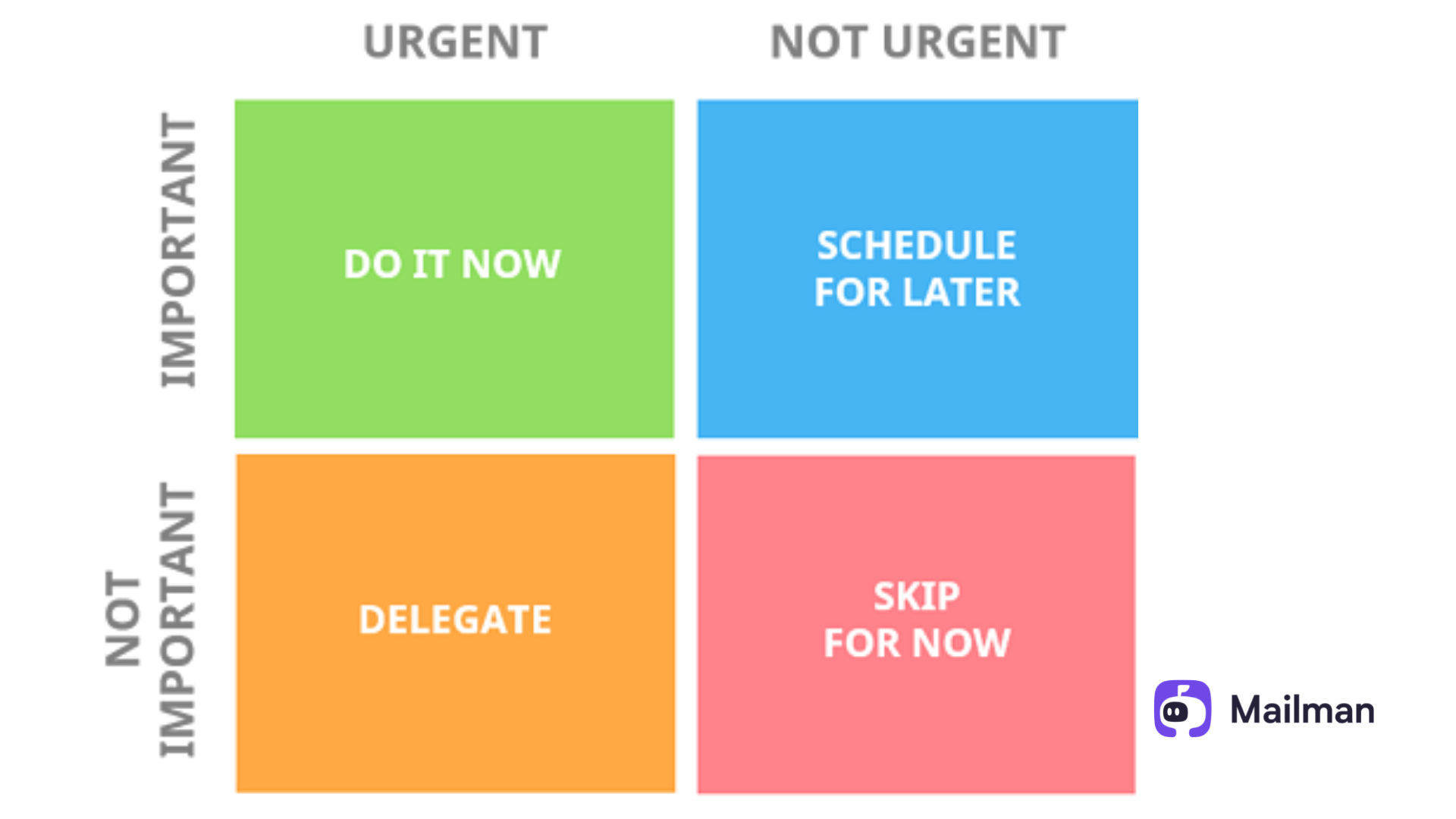How to use The Eisenhower Matrix for time management and be more productive?

Who will you learn how to be productive from?
a) A productivity guru - who has no track record of being productive. Or,
b) A two-times United States President. He was responsible for the launch of NASA, and the internet (DARPA). He made several key decisions that impacted the modern USA.
He was also a 5-star general in the United States Army and the first supreme commander of NATO. Still, he found time for his hobbies, like golfing and oil painting. He has a track record of sustaining productivity for decades.
Of course, the second one! I’m talking about Dwight Eisenhower. He was lauded for being productive in both his military career and presidential term.
His secret? He devised a simple framework, ‘The Eisenhower Matrix.’ In this post, I’ll tell you what that is and how you can use it to work on important tasks and be more productive.
The Eisenhower Matrix is for you if you…
a) Are busy throughout the day, but can't get anything impactful done at the end.
b) Struggle to delegate tasks.
c) Neglect your long-term goals because of frequent in-between tasks.
d) Find yourself stuck between work and have no time to spend with your family and friends.
This article will help you distinguish between what you should do, what you should delegate, and what tasks you should delete.
So, that:
- You work on what matters to you.
- Your short-term and long-term life/career goals align with each other.
- You find work-life balance.
Let’s jump right in!
What is The Eisenhower Matrix?
The Eisenhower Matrix is a 2*2 decision-making tool that helps you distinguish between urgent and important tasks. Because, as Eisenhower said, “What is important is seldom urgent and what is urgent is seldom important.”
Remember:
a) Urgent tasks are those tasks that require immediate attention. You’ve to complete these tasks now - no matter what. For example, submitting a project, taking meetings, or attending clients. You can’t schedule them for tomorrow.
b) Important tasks contribute to your long-term mission and values. These tasks require planning and sometimes do not give immediate results. But, avoiding them will distance you from your life goals. For example, exercising, planning your company’s strategy, or meeting your parents and friends.
‘Important’ is subjective here. It depends on your values and what you want to achieve. No one can define what’s important to you. You should do that.
Note: A task can be both urgent and important.
How to use The Eisenhower Matrix to prioritize important tasks and be productive?
The 2*2 matrix is divided into 4 quadrants.

Quadrant 1: Important and urgent
These tasks are time-sensitive and demand immediate action. You can’t delay them further. They come with consequences if not done on time. These tasks fall in the “Do Now” category.
Some examples:
a) Last-minute deadline project
b) Briefing your clients
Review your daily tasks. See which tasks fit in the 'do first’ quadrant. If the task demands that you do it today, or tomorrow, it’s an urgent task. DO IT NOW.
Quadrant 2: Important, but not urgent
These tasks fall in the ‘decide’ bucket. They don’t come with the ‘urgent’ label but will compound your long-term goals in your life. For example, learning a new skill, exercising, or attending a family gathering.
Be aware of these tasks. Because they may not seem urgent, it’s tempting to put them off. Don’t. Schedule these tasks in a way that you find time to do them.
In his book, The 7 Habits Of Highly Successful People, Stephen Covey says you should aim to optimize your life around Quadrant 2 tasks. Because, unlike Quadrant 1 tasks, you’re not in a constant distraction mode. You can do deep work. These tasks will help you grow in your career and life.
Quadrant 3: Not important, and urgent
These tasks give you the illusion of being busy, but actually, drain your time and energy. But, because they are urgent, you can’t avoid them.
Examples include meetings (that someone else can conduct), constant email notifications, or scheduling interviews.
Quadrant 3 tasks are generally others' tasks forced on you. These tasks block your Quadrant 1 and 2 tasks and isolate you from your goals. You end up doing everyone else's tasks except yours. Not a state you want to be in, isn't it?
The solution is to delegate Quadrant 3 tasks because they don’t require your expertise to be completed. For example, hire a virtual assistant to do mundane tasks. Or use automation tools like Zapier to automate repetitive tasks.
a) Block time for important tasks. Let your co-workers know about this, so they don’t distract you during that time. Set work boundaries with your co-workers.
b) Use Mailman to block emails during your deep work sessions. Receive emails during a preset time.
Quadrant 4: Not important, and not urgent
These tasks suck your time without contributing anything to your goals. They are time-wasting activities and productivity killers. Examples include mindless social media scrolling, watching TV for hours, or engaging in pointless discussions.
Be ruthless in eliminating Quadrant 4 tasks. No leniency.
Remember: Leisure tasks don’t fall in Quadrant 4 tasks. Rest is as important as chasing productivity. Practice your hobbies, read books, sit to re-energize, or do anything else that calms your mind. Even Eisenhower painted and played golf.
Just don’t overdo these tasks. Strike a good balance between work and rest. It won’t happen overnight. But, with enough awareness, you’ll know how much work and rest is optimal for you.
5 tips to use The Eisenhower Matrix to its fullest
1) Write down what’s important to you. Identify what your long-term goals are. What direction do you want to go towards?
Plus, classify what urgent tasks mean to you. Remember, these tasks are time-constrained. But, that doesn’t mean you have to do it. Break down what urgent tasks you should do and what you should delegate.
2) Don’t rush using the matrix. First, track your time across different tasks for 15 days. Review each task. Ask yourself if the task you termed ‘urgent’ was really urgent? Would it have worked if you delegated it? Did you structure your day in the direction of your long-term goals?
Note down what’s working for you and what’s not. It’s OK if the first 15 days of data don’t show your progress. This is just the start.
3) Now that you know how you’re faring, double down on what’s working. Cut down things that are halting your progress.
Structure the following weeks according to what you learned. But, don’t put too many things in the urgent and important quadrants. Limit each quadrant to 4-5 tasks. Reflect on the progress. Rinse and repeat.
4) List down the 4-5 urgent and important tasks one day before. Put it on the calendar. Block the time for each task. The next day, complete these tasks. Take breaks of 15-20 mins between each task.
5) Prioritize your work. Don’t let others dictate what you should do and what you should not. Let them know your schedule, so they don’t bother you.
a) Use freedom to block distracting websites and apps.
b) Use Clockify to track work hours across projects. Get weekly visual breakdowns of your activities. You can view all your time entries as time blocks in it. Get to know when you have gaps in a day. Understand your work patterns to improve them.
c) Schedule family time in your calendar along with the urgent tasks. Make sure you spend time with them. Don’t set the standard of being available 24/7. Set work boundaries.
Use The Eisenhower Matrix for time management and to become more productive
No matter what productivity tools and hacks you use, there will be unexpected events here and there. But, The Eisenhower Matrix will give structure and direction to your time management.
You’ll eliminate tasks that take up your mental energy, and distances yourself away from your long-term goals. You’ll focus on what’s important and fun to do. You’ll even spend your time with family and friends.
That sounds awesome, right?
So, what are you waiting for? Use The Eisenhower Matrix to maximize your productivity.





